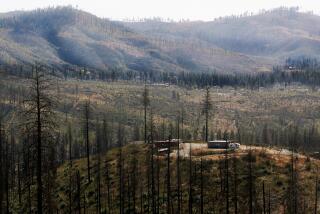Sierra Nevada 40 Million Years Old?
- Share via
The chemical traces of prehistoric raindrops in crumbling boulders have led Stanford University researchers to conclude that the Sierra Nevada is at least 40 million years old, much older than previously thought.
New geological evidence shows that the traditional estimate of 3 million to 5 million years old appears far too low, three Stanford geoscientists said in a paper published in Friday’s issue of the journal Science.
There is no debate about the age of the rocks beneath the Sierra: Radioactive dating shows they are up to 120 million years old. But scientists have not been able to agree on when the rocks lurched up to create the mountain range.
Andreas Mulch, Page Chamberlain and Steve Graham of Stanford’s Department of Geological and Environmental Sciences gathered samples of the mineral kaolinite from dry river tributaries during camping trips in the Sierra starting in 2004. The mineral incorporates water from rainfall or other sources into its crystal structure as it forms.
Subtle variations in hydrogen isotopes within the samples helped the scientists estimate cloud temperatures at the time raindrops fell millions of years ago, which in turn allowed them to estimate the height of the clouds, and thus the height of the range.
The findings are “at odds with more traditional geologic evidence” about primeval mountain-building, and could upend traditional explanations if they are verified, said geologist Craig Jones of the University of Colorado.
“Where this leaves us is that something is wrong, and we are not sure what,” he said. “There could be a weakness in the logic used by Mulch, or there could be something about the ancient river channels that we have grossly misunderstood.”






